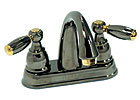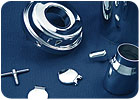
This faucet is plated with TriOnyx®-Black, a black trivalent chromium.
The first commercial trivalent chromium bath, based on a sulfate/chloride electrolyte, was introduced by Albright & Wilson in 1975. Since then, the long-term corrosion protection of trivalent chromium over multilayer nickel deposits has been proven repeatedly. Tests conducted by ASTM have shown that trivalent chromium deposits perform better than standard hexavalent chromium deposits, better than microcracked hexavalent chromium deposits and as good as microporous hexavalent chromium deposits. And the field performance of trivalent chromium has confirmed these results. The trivalent chromium process has been used on bumpers for the over-the-road truck market for more than 15 years, where it has shown an indefinite electrolyte life, process stability, ease of use and excellent exterior corrosion performance. The process also has been used in the custom motorcycle market, where its improved covering power and uniform thickness have eliminated the use of auxiliary anodes for plating difficult geometries.
With the recent move away from hexavalent chromium due to employee safety concerns and environmental regulations, trivalent chromium deserves a closer look as a decorative plating option.

Table 1.
Trivalent Chromium vs. Hexavalent Chromium
Hexavalent chromium offers a lower cost per ampere hour compared to trivalent chromium. However, increasingly stringent regulations limiting hexavalent-chromium use and exposure have forced many electroplaters to search for an alternative. Trivalent chromium is non-carcinogenic, has no lead components for disposal and easily meets air pollution requirements, and thus provides a compliant, effective option.Trivalent-chromium also offers other benefits over hexavalent-chromium, such as no burning or whitewash, tolerance to current interruption, improved covering power, microporosity as plated and no need for filming anodes. It contains substantially less chromium compared to hexavalent-chromium and does not require the use of lead for anodes, thereby reducing waste treatment requirements for both chromium and lead. Simple pH, specific gravity and amp-hour meters are the only solution controls needed, compared to the complex chromic acid, sulfate and ratio analysis required with hex-chrome.
While trivalent chromium is intolerant to impurities, recently developed ion exchange resins allow impurities to be removed easily. Trivalent chromium also offers improved thickness distribution with less macro-cracking compared to hexavalent-chromium. Table 1 shows a side-by-side comparison of trivalent chromium and hexavalent chromium.
Recent Innovations
Recent innovations have produced trivalent chromium deposits in colors that cannot be distinguished from hexavalent chromium deposits. Trivalent chromium deposits that match black chromium, black nickel, titanium, stainless steel and platinum also have been developed. These colored processes have replaced the use of physical vapor deposition (PVD) coatings, providing exceptional corrosion protection at one-tenth the cost of PVD.
This faucet is plated with TriOnyx Stainless, which imitates a stainless color.
Operating Parameters
The main operating parameters for sulfate/chloride electrolyte-based trivalent chromium include temperature, agitation, pH, and cathode and anode current density.Temperature.The temperature is usually maintained between 80-100°F. Higher temperatures favor a faster plating rate at the expense of reduced coverage, while lower temperatures favor a whiter deposit color.
Agitation.Agitation is necessary to replenish the cathode film and maintain temperature uniformity and is usually accomplished with mild air. Generally, lower agitation favors increased coverage and a reduced plating rate.
pH. The pH of the solution affects both the plating speed and the low current density coverage and typically is maintained between 2.5 and 3.5. A low pH produces the highest plating speeds but at the cost of some low current density coverage. Conversely, a high pH will result in slower plating speeds but with some improvement in low current density coverage.
Cathode current density. The cathode current density should be as low as possible while still producing satisfactory work. A low cathode current density will reduce any requirements for cooling, improve rectifier capacity and optimize the consumption of additives.
Increasing the current density will produce good deposit distribution (throwing power) but might not result in improving deposit thickness because the cathode efficiency decreases with increasing current density. Typically, chromium will be deposited at a rate of approximately 4-5 millionths of an inch per minute (0.10-0.125 µ/min), regardless of the cathode current density. The typical cathode current density range is 8 amperes/square decimeter (ASD) and up.
Anode current density. Special trivalent chromium graphite anodes are typically used, and these last indefinitely. The anode current density usually is maintained below 5 ASD.
Solution Composition
Most sulfate/chloride trivalent-chromium solutions consist of makeup salts, the complexing agent and mist suppressants.Makeup salts. The makeup salts contain the chromium salts, conductivity salts and other specialty compounds. This material is usually added in amounts specified by the manufacturer. A typical makeup quantity is 400 g/liter. The concentration is easily maintained by specific gravity or chemical analysis.
Complexing agent. Trivalent chromium must be plated from a complex, which requires a complexing agent. This component is maintained on an amp-hour basis and is augmented with chemical analysis.
Mist suppressants. Mist suppressants are usually added to minimize misting. These materials sometimes improve deposit uniformity and can add some metallic impurity tolerance to the process.

These components are plated with TVC®, a white trivalent chromium.
Effective Protection
Trivalent chromium deposits have been used for more than 30 years. They offer corrosion protection that is better than standard hexavalent chromium deposits and equal to hexavalent microporous chromium deposits, both in real-time corrosion studies and in actual use. Electroplaters have used the process for its operating advantages in the past. However, as safety and environmental regulations force remaining hexavalent chromium electroplaters to switch to alternative processes, trivalent chromium presents an increasingly attractive option.For more information about trivalent chromium, visit www.platingprocess.com.
ONLINE EXCLUSIVE: Troubleshooting Trivalent Chromium.

Report Abusive Comment